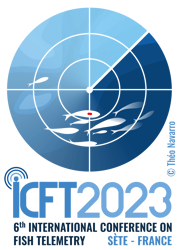Planning
| ‹ Friday, June 16, 2023 | |
|
08:00
09:00
10:00
11:00
12:00
13:00
14:00
15:00
16:00
17:00
|
›8:30 (45min)
How elephant seals help us to observe the Ocean while investigating their foraging ecology
Christophe Guinet › Amphithéâtre bât. CELIMER
8:30 - 9:15 (45min)
How elephant seals help us to observe the Ocean while investigating their foraging ecology
 Amphithéâtre bât. CELIMER Amphithéâtre bât. CELIMER
Christophe Guinet
9:15 - 10:00 (45min)
Talks and Short talks
 Amphithéâtre bât. CELIMER Amphithéâtre bât. CELIMER
Fabien Forget
› Using an acceleration tag to assess the activity and tridimensional space use of the European catfish
- Bernardo Quintella, MARE, Centro de Ciências do Mar e do Ambiente/ ARNET – Rede de Investigação Aquática, Faculdade de Ciências da Universidade de Lisboa, Portugal, Departamento de Biologia Animal, Faculdade de Ciências da Universidade de Lisboa, Lisboa.
09:15-09:30 (15min)
› Multidisciplinary estimates of connectivity suggest the use of multiple units for the conservation and management of meagre, Argyrosomus regius
- David Abecasis, Centre of Marine Sciences, Faro, Portugal
09:30-09:45 (15min)
› Social networks revealed by high-throughput tracking correlate with gut microbiome in marine fish
- Aina Pons Salom, Institut Mediterrani dÉstudis Avancats
09:45-09:52 (07min)
› Meta analysis of Giant Trevally (Caranx ignobilis) Movement Patterns and Home Range Sizes in Hawaiian Waters
- Brittany Evans, Hawai'i Institute of Marine Biology
09:52-10:00 (08min)
10:00 - 10:45 (45min)
Coffee break
 Amphithéâtre bât. CELIMER Amphithéâtre bât. CELIMER
10:45 - 12:15 (1h30)
Talks and Short talks
 Amphithéâtre bât. CELIMER Amphithéâtre bât. CELIMER
Fabien Forget
› Building a telemetry Network in the Nordhordland UNESCO Biosphere: Bergen Telemetry Network
- Knut Vollset, NORCE Norwegian Research Centre, Norway
10:45-11:00 (15min)
› Is your fish out of water? Modifications to a hidden Markov model for reconstructing fish movement pathways in study areas with island topography or convoluted shorelines
- Julie Nielsen, Kingfisher Marine Research
11:00-11:15 (15min)
› Estuarine and in-river survival and migratory behaviour of adult salmonids
- Tea Bašić, Centre for Environment, Fisheries and Aquaculture Science, Lowestoft, UK
11:15-11:22 (07min)
› The advantages and challenges of non-invasive towed PILOT tags for free-ranging deep-diving megafauna
- Jorge Fontes, Okeanos - Institute of Marine Research
11:23-11:30 (07min)
› Integrating fish movescapes, habitat use and connectivity to implement effective ecosystem-based management in a transboundary MPA network.
- Bernat Hereu, Departament de Biologia Evolutiva, Ecologia i Ciències Ambientals, Universitat de Barcelona, Institut de Recerca de la Biodiversitat (IRBio), Universitat de Barcelona, Spain
11:30-11:45 (15min)
› An acclimatization period in a fish farm cage promotes site fidelity of released hatchery-reared dusky groupers
- Ana Filipa Silva, MARE – Centro de Ciências do Mar e do Ambiente/ ARNET - Rede de Investigação Aquática, Faculdade de Ciências da Universidade de Lisboa, Portugal
11:45-12:00 (15min)
› Estimating internal and external tag retention by Walleye (Sander vitreus) over multiple years after release in the Laurentian Great Lakes
- Scott Colborne, Michigan State University, USA
12:00-12:07 (07min)
› Does pathogen burden affect the temperature preference of salmonids?
- Sindre Eldøy, NTNU University Museum, Trondheim, Norway
12:08-12:15 (07min)
12:15 - 14:00 (1h45)
Lunch
 Amphithéâtre bât. CELIMER Amphithéâtre bât. CELIMER
14:00 - 15:15 (1h15)
Talks and Short talks
 Amphithéâtre bât. CELIMER Amphithéâtre bât. CELIMER
Fabien Forget
› Transcending boundaries in fish movement ecology through the European Tracking Network
- Jena Edwards, Royal Netherlands Institute for Sea Research, The Netherlands
14:00-14:15 (15min)
› Using acoustic telemetry to identify critical habitat functions for spatial planning
- Jessica Robichaud, Department of Biology, Carleton University
14:15-14:30 (15min)
› Spatial ecology of non-native common carp (Cyprinus carpio) in Lake Ontario with implications for management
- Morgan Piczak, Carleton University
14:30-14:37 (07min)
› The use of acoustic and RFID tags to study the behaviour of twaite shads at a fish pass (Hérault, France)
- Fanny Alix, Pierre Campton, Association Migrateurs Rhône Méditerranée, France
14:38-14:45 (07min)
› Pulling the plug: Space use and movement of fishes prior to removal of a large dam
- Matthew Acre, United States Geological Survey, USA
14:45-15:00 (15min)
› Homing and movement patterns of Iberian barbel (Luciobarbus bocagei) following translocation in a highly impounded river
- Ana Rato, Centro de Ciências do Mar e do Ambiente/Rede de Investigação Aquática, Portugal
15:00-15:15 (15min)
15:15 - 16:00 (45min)
Coffee break
 Amphithéâtre bât. CELIMER Amphithéâtre bât. CELIMER
16:00 - 17:00 (1h)
Talks and Short talks
 Amphithéâtre bât. CELIMER Amphithéâtre bât. CELIMER
Fabien Forget
› Near Real-Time Ocean Profiles from Animal-Borne Platforms; Sharks as a Case Study
- Kim HOLLAND, Hawaii Institute of Marine Biology, USA
16:00-16:20 (20min)
› Using multiple telemetry and biologging methods to study juvenile sharks and rays in very shallow coastal habitats
- Colin Simpfendorfer, Center for Sustainable Tropical Fisheries and Aquaculture, James Cook University, Australia
16:20-16:40 (20min)
› The European aquatic animal tracking network (ETN) – a timely initiative for the animal tracking community in Europe
- Jan Reubens, Flanders Marine Institute, Belgium
16:40-17:00 (20min)
17:00 - 17:30 (30min)
Closing of the conference
 Amphithéâtre bât. CELIMER Amphithéâtre bât. CELIMER
Marc Soria
|
| Session | Speech | Logistics | Break | Tour |


